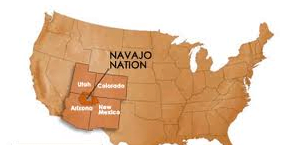Margaret Hiza Redsteer is a geologist of Native American descent who lives in the Navajo Nation, a native American reservation in the state of Arizona. She is known in geologist circles for her pioneering weather, soil and land surveys of Navajo Nation and now it seems she is turning her focus to mapping the effects of climate change.
What is so unique about this project is that she is using oral history and memories to compliment the hard science. High Country News has a fascinating interview with Redsteer about her project. Read on.
High Country News If I was a Navajo child, what would I hear about the weather and climate growing up?
Margaret Hiza Redsteer The elders often talk about the difference in grass, how tall, how thick, how much of it there used to be. Some people say when they were young and herding sheep they had to stay right with the herd. If they didn’t the sheep would get lost in the grass. It’s not like that now.
HCN What have you learned from these oral histories?
Hiza Redsteer The elders’ memories can give us information that the physical records can’t. They give a much better picture of what the ecological changes have been. For example, people talk about how, in the winter, the snow was chest high on the horses. They talk about using particular streams for irrigation of crops, but many of those aren’t even flowing now,
It helps us fill in gaps too. There are huge time gaps in some of the earlier photography. We have a photo set from 1936, for instance, but then the next photo set we have from the area is from 1954. That’s a huge gap in time when you’re trying to unravel how the landscape changed and what caused it.
HCN Is there a difference between the kind of information you can get through oral and analytical methods?
MHR We can model evapotranspiration rates based on temperature; we can make observations of soil moisture. But one thing that we can’t do very easily is project back to what those conditions were like when there was more snow. One of the things we’ve learned (from oral accounts) is that soil moisture conditions were much different. In the Southwest we expect precipitation during two distinct periods: winter rains, followed by a dry windy spring, then the summer monsoons. Springs have become much warmer; we can see that in the meteorological record.
We’ve learned from the elders that the soil stayed moist all through the spring until the summer monsoon arrived. Now, if you were to go out in the springtime during the dry windy season, you could dig a very big trench and not run into any wet sand or soil. The ecological effects are huge because shallow rooted plants aren’t going to do as well.
It’s also hard to reconstruct where plants and animals were in the past. The elders have told us that when there were cottonwoods in the Little Colorado river there were lots of beavers. They used to see cranes migrate through the area in the spring, stopping in the marshes around lakes that aren’t there now.
Emphasis mine. Read the whole interview. And also check out this profile of Redsteer, also from the High Country News.
